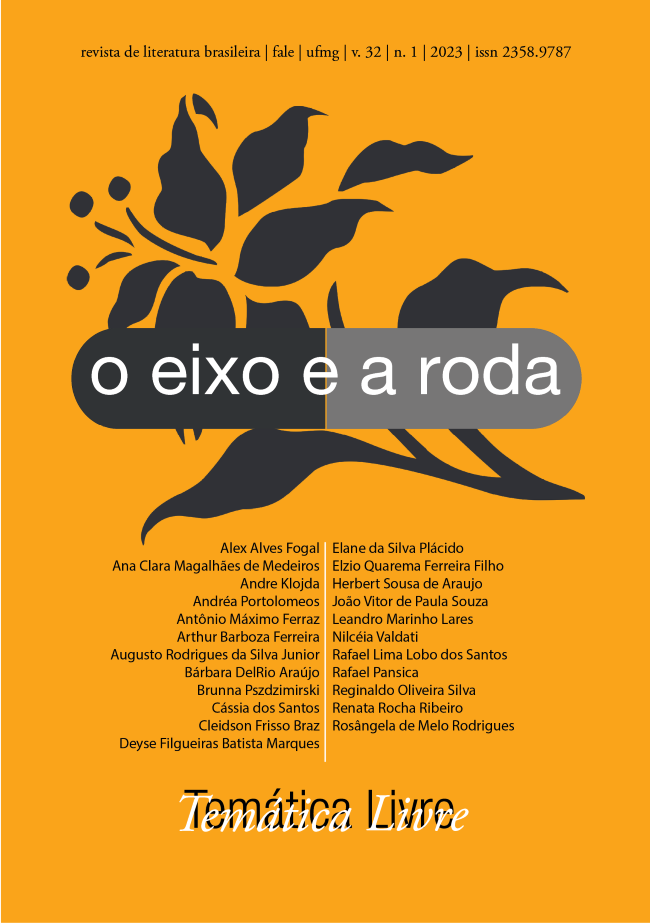A origem do mal
a tríade detetive-criminoso-vítima em O sorriso da hiena, de Gustavo Ávila
DOI:
https://doi.org/10.17851/2358-9787.32.1.186-216Palavras-chave:
literatura brasileira contemporânea, literatura policia, Gustavo Ávila, tríade policial clássica, desestabilização do gênero policialResumo
O presente artigo tem por objetivo analisar as desestabilizações do gênero policial clássico em O sorriso da hiena, obra policial brasileira contemporânea, publicada por Gustavo Ávila em 2017, de modo a evidenciar caracterizações das personagens que compõem a configuração esperada da tríade policial clássica: detetive-criminoso-vítima. Dessa maneira, a fundamentação teórica parte de textos que discutem o gênero policial, desde sua gênese até atualizações desse tipo de narrativa, especialmente no que diz respeito à tríade mencionada, como França & Sasse (2016), Leidens (2019), Marques (2016), Massi (2011), Oliveira (2016), e Todorov (2006). Assim, a partir da análise interpretativa dos trechos do romance, foram tecidos apontamentos que evidenciam como as personagens da narrativa são descritas e como se relacionam no transcorrer da obra, levando à sua reconfiguração. Os resultados indicam, portanto, que os componentes da tríade policial clássica não são categorias rígidas ou estanques, mas antes, elementos bastante flexíveis e adaptáveis a diferentes épocas, culturas e obras. Desse modo, ilustra-se uma desestabilização, ainda que parcial, do gênero policial clássico, tendo em vista que a obra de Ávila apresenta caracterizações e relações entre as personagens que podem ser descritas como inovadoras e, nesse sentido, possibilitam reflexões não esperadas ou não observadas em obras clássicas, o que testemunha a inventividade do gênero policial, sempre propício a algum tipo de evolução, tanto no nível formal como no temático.
Referências
ÁVILA, G. O sorriso da hiena. Campinas, SP: Verus, 2017.
CARVALHO, P. A. “Mattos, Malta ou Matta?: o policial em Aluísio Azevedo”. Cadernos do CNLF, v. X, 8., 2006. Disponível em: http://www.filologia.org.br/xcnlf/8/13.htm Acesso 09/03/2023.
EBLE, L. J. A literatura brasileira e a permanência do cânone na academia.
Observatório Itaú Cultural, 2014, p. 142-153.
FRANÇA, J.; SASSE, P. P. O Fascínio do Crime: João do Rio e as raízes da literatura policial no Brasil. In: VIEGAS, A. C. C.; PONTES JR, G.; MARQUES, J. L. (Orgs.). Configurações da Narrativa Policial. Rio de Janeiro: Dialogarts Publicações, 2016, p. 70-91.
JAMES, P. D. Segredos do romance policial: história das histórias de detetives.
Tradução de José Rubens Siqueira. São Paulo: Três Estrelas, 2012.
LEIDENS, A. Intersecções entre a estética da recepção e o romance policial brasileiro contemporâneo: a elegia do menor pela recepção estética. 2019. 151 f. Dissertação (Mestrado em Letras) – Universidade Tecnológica Federal do Paraná, Pato Branco, 2019.
MARQUES, J. L. Um caso em investigação: o gênero policial. In: VIEGAS, A. C. C.; PONTES JR, G.; MARQUES, J. L. (Orgs.). Configurações da Narrativa Policial. Rio de Janeiro: Dialogarts Publicações, 2016, p. 221-228.
MASSI, F. O romance policial do século XXI. São Paulo: Cultura Acadêmica, 2011.
OLIVEIRA, S. B. A recepção crítica do romance policial no Brasil. In: VIEGAS, A. C. C.; PONTES JR, G.; MARQUES, J. L. (Orgs.). Configurações da Narrativa Policial. Rio de Janeiro: Dialogarts Publicações, 2016, p. 138-158.
SILVA, Pedro Puro Sasse da Silva. Terror e crime na literatura brasileira finissecular. 2016. 153 f. Dissertação (Mestrado em Letras) – Instituto de Letras, Universidade do Estado do Rio de Janeiro, Rio de Janeiro, 2016.
TODOROV, T. As estruturas narrativas. Tradução de Leyla Perrone-Moisés. São Paulo: Perspectiva, 2006.










